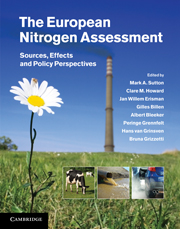Book contents
- Frontmatter
- Contents
- List of contributors
- Foreword
- Summary for policy makers
- Technical summary
- 1 Assessing our nitrogen inheritance
- Part I Nitrogen in Europe: the present position
- Part II Nitrogen processing in the biosphere
- Part III Nitrogen flows and fate at multiple spatial scales
- Part IV Managing nitrogen in relation to key societal threats
- 17 Nitrogen as a threat to European water quality
- 18 Nitrogen as a threat to European air quality
- 19 Nitrogen as a threat to the European greenhouse balance
- 20 Nitrogen as a threat to European terrestrial biodiversity
- 21 Nitrogen as a threat to European soil quality
- Part V European nitrogen policies and future challenges
- Glossary
- Index
- References
17 - Nitrogen as a threat to European water quality
from Part IV - Managing nitrogen in relation to key societal threats
Published online by Cambridge University Press: 16 May 2011
- Frontmatter
- Contents
- List of contributors
- Foreword
- Summary for policy makers
- Technical summary
- 1 Assessing our nitrogen inheritance
- Part I Nitrogen in Europe: the present position
- Part II Nitrogen processing in the biosphere
- Part III Nitrogen flows and fate at multiple spatial scales
- Part IV Managing nitrogen in relation to key societal threats
- 17 Nitrogen as a threat to European water quality
- 18 Nitrogen as a threat to European air quality
- 19 Nitrogen as a threat to the European greenhouse balance
- 20 Nitrogen as a threat to European terrestrial biodiversity
- 21 Nitrogen as a threat to European soil quality
- Part V European nitrogen policies and future challenges
- Glossary
- Index
- References
Summary
Executive summary
Nature of the problem
Anthropogenic increase of nitrogen in water poses direct threats to human and aquatic ecosystems. High nitrate concentrations in drinking water are dangerous for human health. In aquatic ecosystems the nitrogen enrichment produces eutrophication, which is responsible for toxic algal blooms, water anoxia, fish kills and habitat and biodiversity loss.
The continuous nitrogen export to waters reduces the capacity of aquatic ecosystems to absorb, reorganise and adapt to external stress, increasing their vulnerability to future unexpected natural or climate events.
Key findings/state of knowledge
Nitrogen concentrations in European rivers, lakes, aquifers and coastal waters are high in many regions. In addition nitrate concentrations are increasing in groundwaters, threatening the long term quality of the resource.
In Europe, nitrogen pressures occur over large areas, implying elevated costs for meeting the long-term good chemical and ecological water quality requirements. A significant part of the European population could be potentially exposed to high nitrate values in drinking water if adequate treatments were not in place. Furthermore many of European aquatic ecosystems are eutrophic or at risk of eutrophication.
Nitrogen pressures have reduced biodiversity and damaged the resilience of aquatic ecosystems and continue to pose a threat to the aquatic environment and to the provision of goods and services from the aquatic ecosystems.
Even under favourable land use scenarios the nitrogen export to European waters and seas is likely to remain significant in the near future. The effects of climate change on nitrogen export to water are still uncertain.
- Type
- Chapter
- Information
- The European Nitrogen AssessmentSources, Effects and Policy Perspectives, pp. 379 - 404Publisher: Cambridge University PressPrint publication year: 2011
References
- 66
- Cited by



